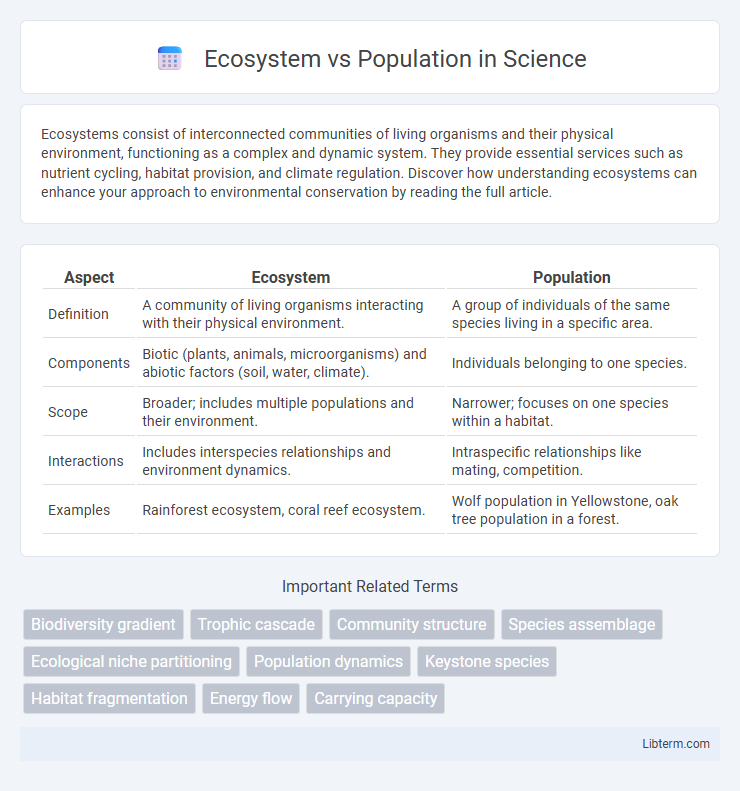Ecosystems consist of interconnected communities of living organisms and their physical environment, functioning as a complex and dynamic system. They provide essential services such as nutrient cycling, habitat provision, and climate regulation. Discover how understanding ecosystems can enhance your approach to environmental conservation by reading the full article.
Table of Comparison
| Aspect | Ecosystem | Population |
|---|---|---|
| Definition | A community of living organisms interacting with their physical environment. | A group of individuals of the same species living in a specific area. |
| Components | Biotic (plants, animals, microorganisms) and abiotic factors (soil, water, climate). | Individuals belonging to one species. |
| Scope | Broader; includes multiple populations and their environment. | Narrower; focuses on one species within a habitat. |
| Interactions | Includes interspecies relationships and environment dynamics. | Intraspecific relationships like mating, competition. |
| Examples | Rainforest ecosystem, coral reef ecosystem. | Wolf population in Yellowstone, oak tree population in a forest. |
Introduction to Ecosystems and Populations
Ecosystems consist of living organisms interacting with their physical environment, forming complex networks of energy flow and nutrient cycling. Populations refer to groups of individuals of the same species living in a specific area, focusing on their size, density, and genetic variation. Understanding the relationship between ecosystems and populations is essential for studying biodiversity, species interactions, and environmental sustainability.
Defining Ecosystem: Components and Functions
An ecosystem consists of biotic components, including plants, animals, and microorganisms, interacting with abiotic components like soil, water, air, and sunlight to form a functional unit. These components work together through energy flow and nutrient cycling, maintaining ecosystem stability and supporting biodiversity. Ecosystem functions include primary production, decomposition, and habitat provision, which sustain life and ecological balance within a geographical area.
Understanding Population in Ecology
Population in ecology refers to a group of individuals of the same species living in a specific geographic area at a given time, interacting and interbreeding. Understanding population dynamics involves studying factors like birth rates, death rates, immigration, and emigration to assess growth patterns and stability. These insights are crucial for managing species conservation, predicting environmental impacts, and maintaining ecosystem balance.
Key Differences Between Ecosystem and Population
An ecosystem encompasses all living organisms interacting with their physical environment, including abiotic factors such as water, soil, and climate, while a population specifically refers to a group of individuals of the same species living in a defined area. Ecosystem dynamics involve energy flow and nutrient cycling across multiple species and habitats, whereas population dynamics focus on birth rates, death rates, and migration affecting a single species. Understanding these distinctions aids ecological research, conservation strategies, and resource management.
Interconnections: How Populations Interact Within Ecosystems
Populations interact within ecosystems through complex food webs and nutrient cycles that maintain ecological balance, where species depend on one another for resources such as food, shelter, and pollination. These interconnections drive energy flow and influence population dynamics, shaping the structure and function of the ecosystem. Understanding these relationships helps ecologists predict the impact of environmental changes on biodiversity and ecosystem health.
Importance of Biodiversity in Maintaining Ecosystems
Biodiversity is crucial for maintaining ecosystem stability, resilience, and productivity by supporting a wide range of species and genetic variation within populations. Diverse ecosystems enhance nutrient cycling, pollination, and habitat provision, which help sustain populations and their interactions. Conservation of biodiversity ensures ecosystem services essential for human survival and environmental health.
Population Dynamics and Ecosystem Balance
Population dynamics study the changes in population size and composition over time, influenced by birth rates, death rates, immigration, and emigration, which directly impact ecosystem balance. Variations in population sizes of key species can disrupt food webs, nutrient cycling, and habitat structure, leading to shifts in ecosystem stability and resilience. Understanding these interactions is crucial for managing biodiversity and ensuring the sustainability of ecosystems in the face of environmental changes.
Human Impact on Ecosystems and Populations
Human activities such as deforestation, pollution, and urbanization significantly disrupt ecosystems by altering habitats and reducing biodiversity within populations. These impacts lead to imbalances in food chains, species extinction, and diminished ecosystem services like clean air and water. Conservation efforts and sustainable resource management are critical to mitigating these effects and preserving both ecosystems and their populations.
Conservation Strategies for Ecosystems and Populations
Conservation strategies for ecosystems emphasize habitat restoration, protection of biodiversity hotspots, and maintaining ecological processes to ensure ecosystem resilience. Population-focused conservation targets species-specific actions such as genetic diversity preservation, population monitoring, and captive breeding programs to prevent extinction. Integrated approaches combine ecosystem management with species conservation to promote sustainability and adaptive capacity in changing environments.
Future Perspectives: Sustaining Healthy Ecosystems and Populations
Sustaining healthy ecosystems and populations requires integrating advanced monitoring technologies and adaptive management strategies to address climate change and habitat loss. Future perspectives emphasize fostering biodiversity resilience through conservation efforts and restoring ecological balance to support population stability. Collaborative policies and community engagement play crucial roles in maintaining ecosystem services vital for human well-being and species survival.
Ecosystem Infographic

 libterm.com
libterm.com